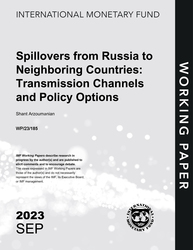
Spillovers from Russia to Neighboring Countries: Transmission Channels and Policy Options
Spillovers from Russia to Neighboring Countries: Transmission Channels and Policy Options
READ MORE...
Volume/Issue:
Volume 2023
Issue 185
Publication date: September 2023
ISBN: 9798400254871
$20.00
Add to Cart by clicking price of the language and format you'd like to purchase
Available Languages and Formats
| English |
Prices in red indicate formats that are not yet available but are forthcoming.
Topics covered in this book
This title contains information about the following subjects.
Click on a subject if you would like to see other titles with the same subjects.
Exports and Imports , Economics- Macroeconomics , Economics / General , Spillovers , international business cycles , trade , remittances , FDI , market confidence , emerging markets , output fluctuation , policy option , spillovers from Russia , CIS economy , Annex I , data definition , Business cycles , Oil prices , Exports , Global
Summary
This paper studies how output fluctuations in Russia are transmitted internationally. Using vector autoregression (VAR) and dynamic panel models, the paper finds that Russia’s output fluctuations are an important driver of output fluctuations of countries in the region, especially for oil importers, and are transmitted increasingly via trade and market confidence channels. The magnitude of cross-border spillovers is larger for countries with relatively high bilateral trade concentration, low export diversification, and weak external buffers. The paper also finds evidence that stronger public institutional quality- especially in the fiscal area- may help insulate countries from volatility in the Russian sovereign debt market.
Copyright © 2010 - 2025
Powered by:
AIDC



